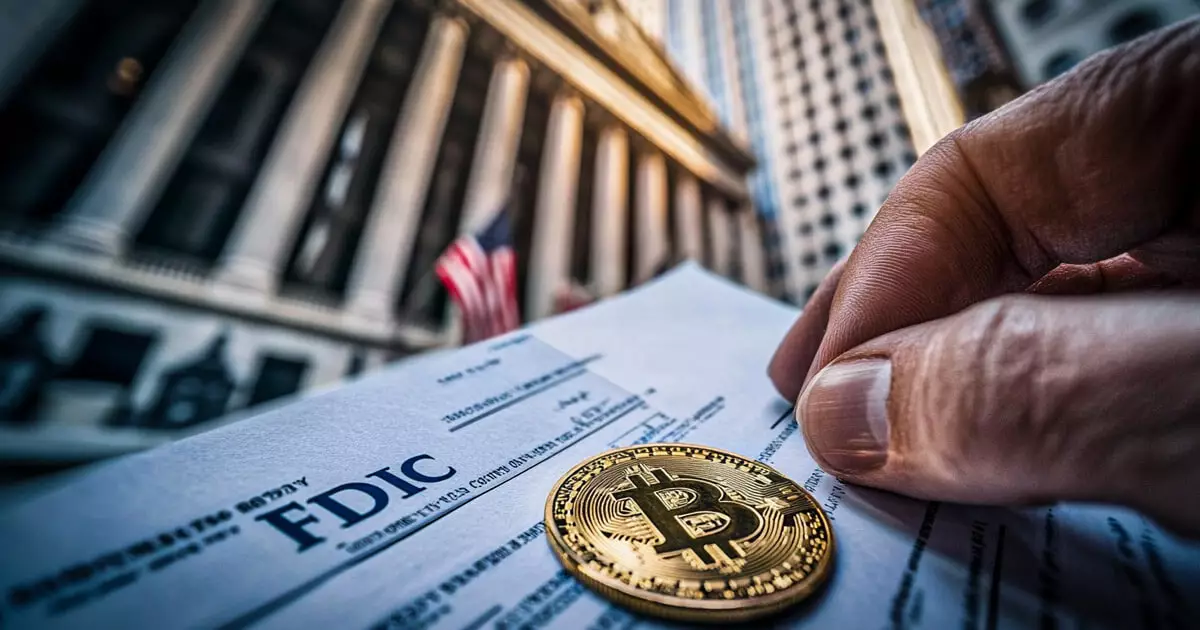The Federal Deposit Insurance Corporation (FDIC) recently took a monumental step by announcing an updated guidance regarding crypto-related activities within banks under its supervision. This decision, which came to light on March 28, 2025, exemplifies a sharp pivot from previous restrictions and reveals a deeper understanding of the crypto landscape that has evolved in recent years. By allowing banks to engage in crypto activities without prior approval, as long as they adhere to risk management practices, the FDIC appears to be embracing financial innovation rather than suffocating it under bureaucratic weight.
Acting Chairman Travis Hill has vocalized this proactive stance, asserting that the FDIC is shedding its outdated methods. This announcement could be viewed not just as an easing of restrictions but as a chance to flourish in a rapidly changing financial ecosystem. It’s an acknowledgment of the stark divide between outdated regulatory approaches and the vibrant digital world that many institutions now wish to explore. However, this transformation raises questions about whether this bold move is genuinely rooted in innovation or merely a reaction to external pressures.
Hurdles of the Past: A Lesson in Resistance
Until now, the narrative surrounding the FDIC and cryptocurrencies has often veered towards skepticism. Banks attempting to dip their toes into the crypto waters found themselves receiving “pause” letters that insisted on a halt to initiatives like custody services and digital asset offerings. Many crypto advocates termed this aggressive pushback as “Operation Chokepoint 2.0,” a move purportedly aimed at stifling the burgeoning sector. Hill’s recent criticism of such opaque enforcement tactics further underscores the debilitating nature of the old paradigm, and the potential for lost opportunities for innovation.
The fact that over 20 banks were forced into regulatory limbo without formal rulemaking is indicative of a system that stifles creativity in favor of fear-based governance. By pivoting away from such practices, it appears that the FDIC is finally recognizing the importance of transparency and clear guidance—a shift that will potentially revitalize banks’ engagement with innovative financial solutions.
Restructuring the Regulatory Framework: A Forward-Thinking Approach
Hill’s insistence that compliance with the Bank Secrecy Act (BSA) should not result in non-access to banking services speaks volumes about his intent to reshape the regulatory landscape. By promoting the examination of how the BSA is applied, Hill fosters a space for experimentation and progress without the threat of regulatory penalties looming overhead. One might argue that a well-defined and reasonable regulatory framework could encourage financial institutions to embrace blockchain technology with open arms, leading to unprecedented possibilities for enhancement in backend operations and customer services.
The FDIC’s increasing coordination with other regulatory bodies, particularly the U.S. Securities and Exchange Commission (SEC), signals a movement towards a cohesive understanding of digital assets. Instead of isolated regulations that prevent adaptation and growth, a united front could enable banks to follow clear guidelines while remaining active participants in the digital realm.
Innovation and Adoption: A Balancing Act
Bo Hines, the Executive Director of the Presidential Working Group on Digital Assets Markets, described FDIC’s decision as a “huge step forward.” But does this guidance truly support the ambitions of banks and the burgeoning crypto industry? While it’s laudable to see regulatory bodies adopting a more lenient stance, this guidance must be paired with practical frameworks and tools to ensure that the promise of innovation doesn’t lead to reckless speculation.
Navigating this uncharted territory will require comprehensive strategies, and the FDIC is challenged to strike a balance between encouraging innovation and ensuring the soundness of institutions. With the market’s volatility, can regulators fundamentally change their approach to risk assessment without compromising the very safety they aim to uphold?
The Path Ahead: Challenges and Opportunities
Despite the positivity surrounding this policy shift, it’s crucial to remember that the road ahead is fraught with challenges. How will regulators respond to crises that may arise from increased engagement in the cryptocurrency sector? Will these new policies hold up under the pressures of potential market downturns or shakeups?
In embracing innovation, the FDIC has the chance not just to redefine its own policies but to inspire a generational change in how financial institutions conceive risk and opportunity. This could usher in a new wave of banking that is agile, responsive, and genuinely in tune with the needs of modern consumers who are increasingly looking toward digital assets. The question remains: will they seize this moment as a chance for foundational realignment or simply as a stopgap measure that falters when faced with real challenges?


















